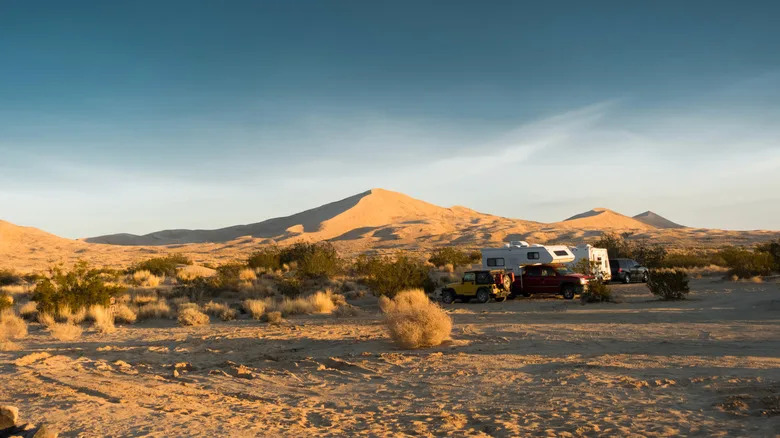We may receive a commission on purchases made from links.
Any outdoor enthusiast who values unique destinations — and anyone who knows they enjoy wild camping experiences — owes it to themself to spend a night under the stars at the Kelso Dunes. Although hiking is the primary reason visitors come to the area, which is the most popular hiking trail inside Mojave National Preserve, it is possible to camp here, albeit under certain conditions.
For starters, while there are some developed campgrounds within Mojave National Preserve, the area around the Kelso Dunes is dispersed camping only. However, this does not mean you can just pitch your tent or park your RV anywhere: Camping at the trailhead is prohibited. Camping is also allowed only within the established undeveloped campsites, so do not attempt to create your own. Additionally, while there are no fees for these undeveloped sites, they cannot be reserved. Instead, they are divvied out on a first-come, first-served basis.
It is also important to note that, while some of the undeveloped campsites allow RVs, not all of them do. So, it is important to check the preserve’s website to identify RV-friendly campsites before your trip. Even those sites that do accommodate RVs have no amenities, however, so be prepared to dry camp if you take your RV to Kelso Dunes. You should also be prepared to bring all of your needed supplies, including firewood, as the preserve is fairly isolated and harvesting firewood here is not allowed. It is also important to practice the principles of Leave No Trace in order to minimize your impact on the ecosystem and ensure you are camping in a responsible and sustainable manner.
Read more: 13 Creatures To Beware Of When Adventuring In California’s Deserts
How to camp safely in the Kelso Dunes
vehicles and campers at Kelso Dunes – t.photo.47/Shutterstock
The Kelso Dunes may be a unique destination for campers, but you’ll need to take certain precautions to stay safe. The 3-mile trail that covers the dunes gains as much as 600 feet in elevation at some points. While this provides incredible views, it can also be incredibly taxing. Make sure you stay hydrated, wear sunscreen, hike in a group, and avoid walking during peak heat. Hydration packs like the CamelBak Hydrobak are recommended as a convenient way to carry an adequate amount of fluids.
It is also important to keep an eye out for dangerous wildlife while trekking through the Kelso Dunes. Although wildlife watching and photography are among the more popular activities here, there are dangerous creatures to beware of when adventuring in California’s deserts. Among the more common of these potentially hazardous critters are rattlesnakes and scorpions. So, be sure you know what to do if you encounter a rattlesnake while hiking, and watch where you put your hands and feet while you’re on the dunes.
When you do encounter wildlife, always stay a safe distance away — whether you believe those creatures to be dangerous or not. Given that the Kelso Dunes are home to some rare creatures, including more than half a dozen species of endemic insects, the Mojave fringe-toed lizard, and desert tortoises, it is only natural to want to get a good look at them. However, even then, you should stay far enough away that the animal doesn’t notice you, and use your zoom to get up close shots.
Want more design inspiration? Join our free newsletter to get the best home and garden tips, design hacks, and DIY projects delivered right to your inbox.
Read the original article on Outdoor Guide.

